Customize Windows Store for Business
Since the creation of Windows 8.0 and 8.1, Microsoft has focused on upgrading its Internet portal Windows Store. I think many would agree that, compared to the Apple Store, the Microsoft Store was rather underdeveloped in terms of application availability and usability of the store interface.
With the release of Windows 10 in 2015, Windows Store has undergone a radical change regarding the availability of applications, games and tools. All this is good for the consumer market segment, but how about adding functionality to business users? Microsoft has done it! Since there was no previous integration of Windows Store in a domain environment, this led to problems with managing purchases and licensing potential applications, not to mention many other problems.
Previously, commercial enterprises were faced with the provision of financial and accounting statements when an employee of the company needed an application from the Windows Store. How to control access, ownership and licensing of the current application? In short, all this was not controlled. In addition, it was not possible to reassign the license. For example, if an employee leaves, the application, so to speak, “leaves” with him.
')
Since users previously purchased applications from the store using their personal Microsoft Live ID accounts, users can now buy the application using their main work accounts, which administrators can set up and manage in their personalized Microsoft Windows Store for business. This requires that the users who are granted access have accounts in the Azure cloud .
In order to successfully register for free access to the Windows Store for Business, you need the following:
The user can create an account in the Windows Store for business on the Microsoft website at the link .
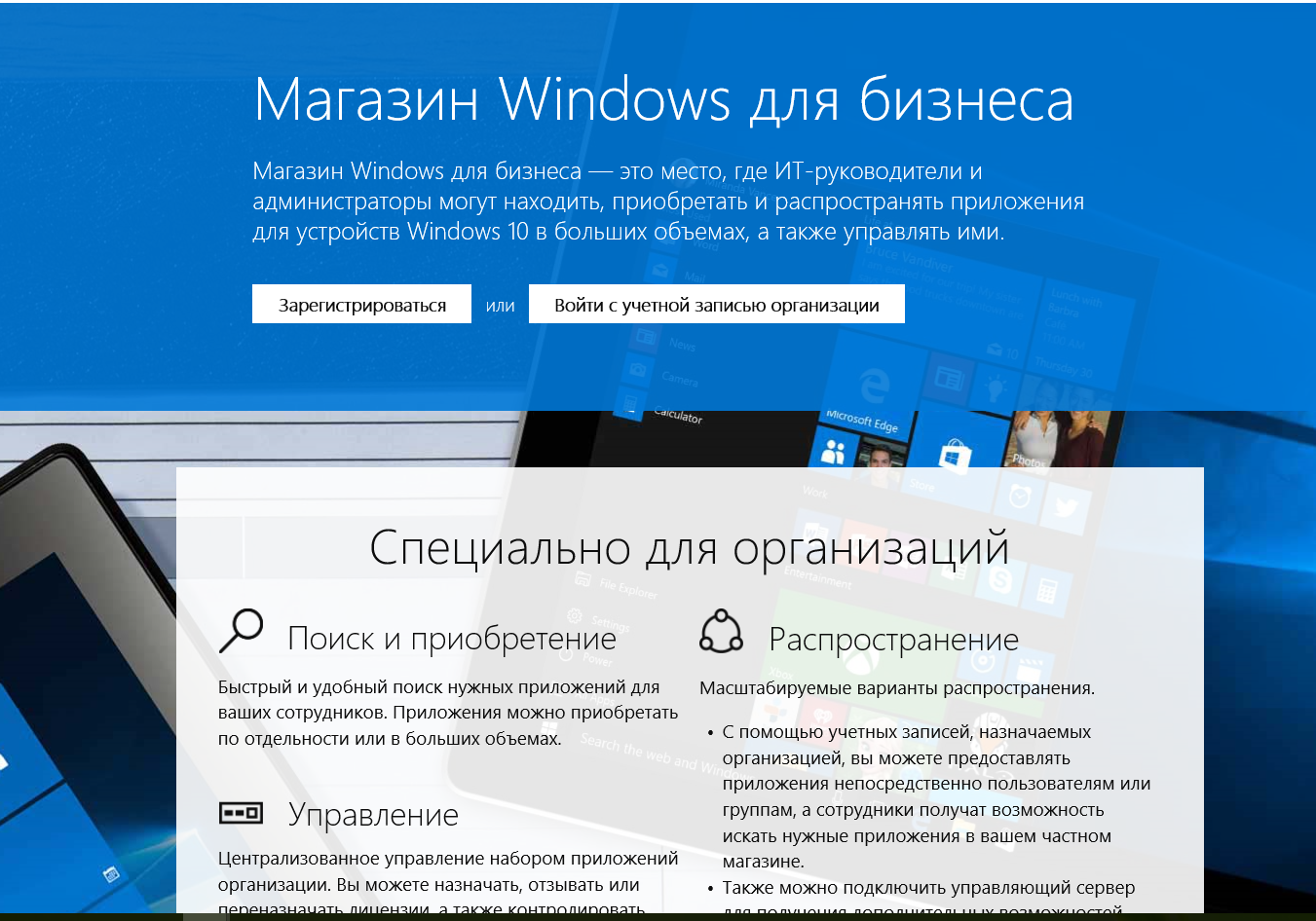
Windows Store for Business is currently available in the following countries and regions:
For those organizations that require a more detailed overview of data and application deployment management, additional System Distribution Manager Configuration Manager, Intune and / or other mobile device management services can be used.
There are certain permissions that can be assigned to users of the corresponding organization. To assign certain privileges, a user with the role of a global administrator on the portal will need to assign the necessary rights in the Windows Store.
Please note that at present it is possible to assign permissions only for each user individually from the physical portal. In order to assign a group affiliation, you must use Microsoft Azure or SCCM.
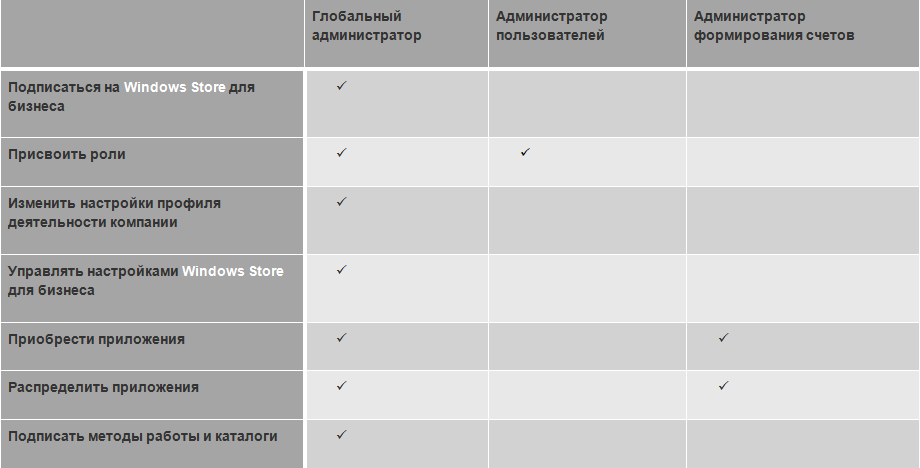

“Global Administrator” or “Customer” have the right to purchase applications and choose whether to assign these applications to the company's Private Store or assign them directly to individual users. Usually applications in a private store become available within 12 hours.
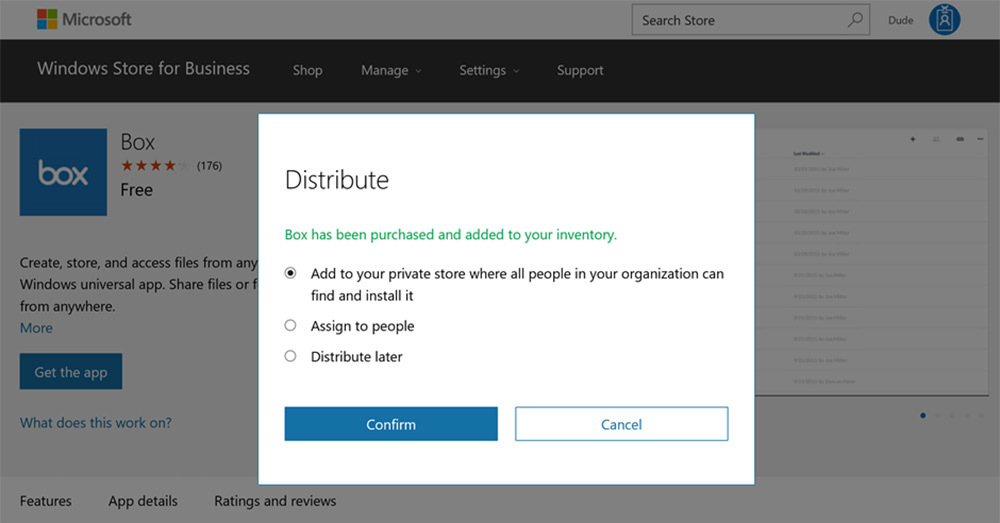
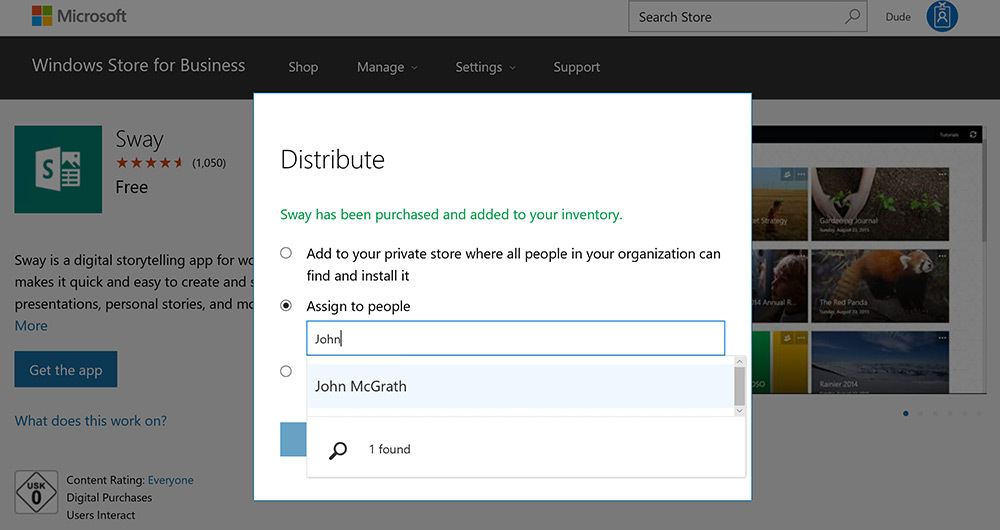
Private Store is a Windows Store for Business feature that organizations receive during registration. When administrators add applications to a private store, all employees of the organization can view and download them. Here the user has an overview of all the applications that were directly assigned to him and he will have the opportunity to download them.
If the user decides that he would like to choose his own application, he will receive a request to enter his personal data: the name and password of Microsoft Live.
With stand-alone licenses, organizations can download applications and licenses to deploy them on a network or on devices without an Internet connection.
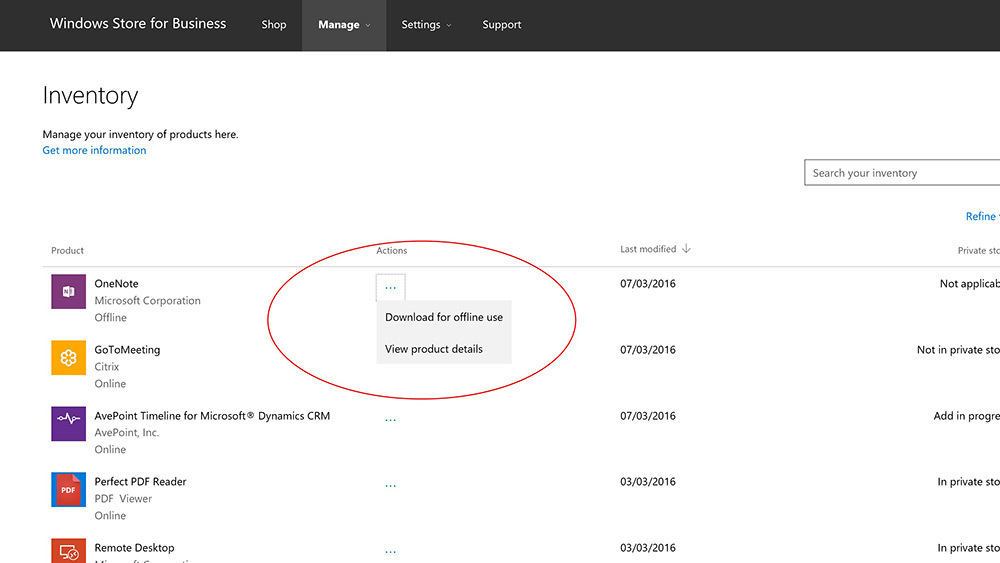
Distributing offline applications is an alternative option to network applications. Deploying standalone applications may be a worthwhile solution in the following cases:
Your master data management tool (MDM) must be configured in the Azure Ad Portal portal and listed in the Windows Store for Business in the Management tools section.
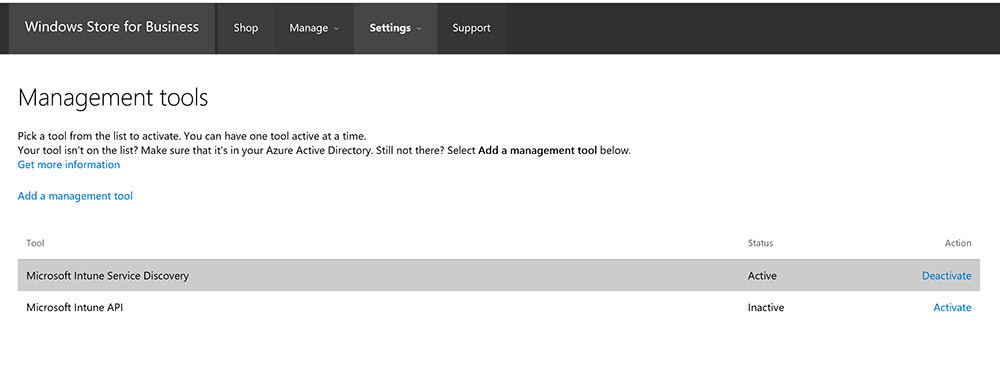
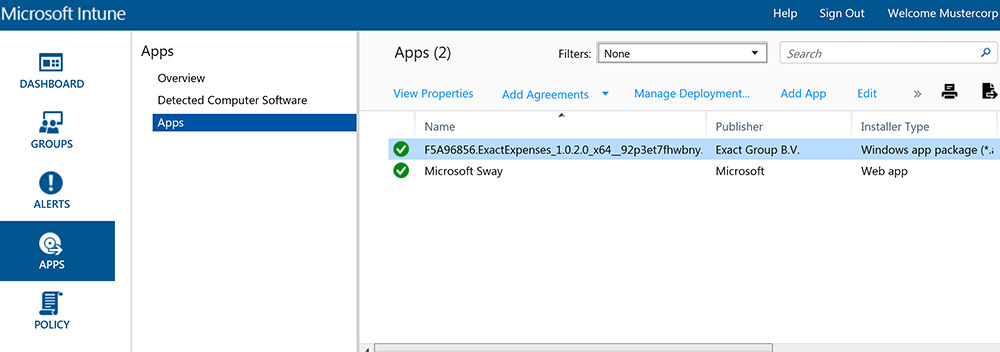
Through the use of personalized Windows Store for Business, your organization has the opportunity to develop and publish its own custom applications in a private information store to speed up distribution within your organization.
The application developers in your organization or the external suppliers you invite can become publishers of business applications and submit applications to your company. The application becomes available only for your company.
Applications are requested through the Windows Dev Center (Windows Dev Center) and can be managed and deployed using the same methods that were illustrated earlier.
However, before initiating, you must fulfill some requirements:
Windows Store for Business offers medium and large businesses the benefits of a portal of flexible distribution of applications according to individual customer requirements. Additional benefits include the ability to publish their own custom software on their own portal.
Bulk purchases and license reassignment allow companies to reduce costs, since the software remains the property of the organization, in contrast to what it used to be when individual users who needed the application had to use their personal Microsoft Live accounts.
Local use also remains an effective solution for the above scenarios, where a third party distribution solution is used. Microsoft will continue to add functionality to the store and a variety of versatile applications.
With the release of Windows 10 in 2015, Windows Store has undergone a radical change regarding the availability of applications, games and tools. All this is good for the consumer market segment, but how about adding functionality to business users? Microsoft has done it! Since there was no previous integration of Windows Store in a domain environment, this led to problems with managing purchases and licensing potential applications, not to mention many other problems.
Previously, commercial enterprises were faced with the provision of financial and accounting statements when an employee of the company needed an application from the Windows Store. How to control access, ownership and licensing of the current application? In short, all this was not controlled. In addition, it was not possible to reassign the license. For example, if an employee leaves, the application, so to speak, “leaves” with him.
')
Since users previously purchased applications from the store using their personal Microsoft Live ID accounts, users can now buy the application using their main work accounts, which administrators can set up and manage in their personalized Microsoft Windows Store for business. This requires that the users who are granted access have accounts in the Azure cloud .
A few words about the benefits
- Organizations can purchase large amounts of Windows Apps
- Procurement based on the example of organizational identity. Mustercorp.com
- Flexible distribution
- Restore and reuse licenses
- Creating a private information store (Private Store) for its employees, which includes applications from the store, as well as Private LOB Apps
Basic requirements
In order to successfully register for free access to the Windows Store for Business, you need the following:
- Azure Active Directory directory service account
- You must be the “Global Administrator” of your organization in Azure AD Tenant.
Technical requirements
- Internet Explorer 10 or later
- Microsoft edge
- Current versions of Firefox and Chrome
- Microsoft Azure AD Employee Accounts
How to do this?
The user can create an account in the Windows Store for business on the Microsoft website at the link .

Worldwide availability
Windows Store for Business is currently available in the following countries and regions:
- Australia
- Belgium (Dutch, French)
- Brazil
- Canada (English, French)
- Finland
- France
- Germany
- India
- Indonesia
- Ireland
- Italy
- Japan
- Mexico
- Netherlands
- Poland
- Russia
- Spain
- Sweden
- Switzerland (French, German)
- Great Britain
- USA
Management and distribution
For those organizations that require a more detailed overview of data and application deployment management, additional System Distribution Manager Configuration Manager, Intune and / or other mobile device management services can be used.
There are certain permissions that can be assigned to users of the corresponding organization. To assign certain privileges, a user with the role of a global administrator on the portal will need to assign the necessary rights in the Windows Store.
Please note that at present it is possible to assign permissions only for each user individually from the physical portal. In order to assign a group affiliation, you must use Microsoft Azure or SCCM.

- Global administrator - this role assumes full access to the store for business. Global administrators can do everything that is allowed for an administrative role, including they can subscribe to the Windows Store for business and assign roles in the store to other employees of the company.
- The user administrator can assign roles to the Windows Store for business to other employees, provided that the user administrator also has an administrative role.
- Administrator billing - this "account" has the same permissions as the buyer of the Windows Store for business.
Windows Store for Business Roles and Permissions

Application assignment
“Global Administrator” or “Customer” have the right to purchase applications and choose whether to assign these applications to the company's Private Store or assign them directly to individual users. Usually applications in a private store become available within 12 hours.


Private Store is a Windows Store for Business feature that organizations receive during registration. When administrators add applications to a private store, all employees of the organization can view and download them. Here the user has an overview of all the applications that were directly assigned to him and he will have the opportunity to download them.
If the user decides that he would like to choose his own application, he will receive a request to enter his personal data: the name and password of Microsoft Live.
Distribute offline applications
With stand-alone licenses, organizations can download applications and licenses to deploy them on a network or on devices without an Internet connection.

Distributing offline applications is an alternative option to network applications. Deploying standalone applications may be a worthwhile solution in the following cases:
- Users have no Azure accounts
- No internet connection
- Imaging is used to control devices.
Your master data management tool (MDM) must be configured in the Azure Ad Portal portal and listed in the Windows Store for Business in the Management tools section.


Personal Business Application Line (LOB)
Through the use of personalized Windows Store for Business, your organization has the opportunity to develop and publish its own custom applications in a private information store to speed up distribution within your organization.
The application developers in your organization or the external suppliers you invite can become publishers of business applications and submit applications to your company. The application becomes available only for your company.
Applications are requested through the Windows Dev Center (Windows Dev Center) and can be managed and deployed using the same methods that were illustrated earlier.
However, before initiating, you must fulfill some requirements:
- Your organization must be subscribed to the Windows Store for Business
- Business Applications Publishers Need Active Developer Account
- Business application publishers must have an in-store application or one application ready for publication.
And in conclusion
Windows Store for Business offers medium and large businesses the benefits of a portal of flexible distribution of applications according to individual customer requirements. Additional benefits include the ability to publish their own custom software on their own portal.
Bulk purchases and license reassignment allow companies to reduce costs, since the software remains the property of the organization, in contrast to what it used to be when individual users who needed the application had to use their personal Microsoft Live accounts.
Local use also remains an effective solution for the above scenarios, where a third party distribution solution is used. Microsoft will continue to add functionality to the store and a variety of versatile applications.
Source: https://habr.com/ru/post/309928/
All Articles